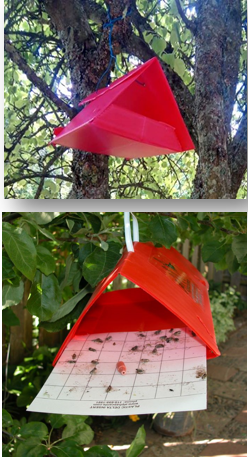Delta Trap

A robust monitoring system for small to medium sized moths
The Delta trap is an ideal trapping device for the monitoring of Lepidoptera pests in both indoor and outdoor growing areas that are commonly affected by this type of pest. The trap is made of a durable, corrugated plastic that is UV and rain resistant, enabling its use across several seasons. The trap is quick and easy to assemble and simply requires the addition of a pheromone lure, which when placed in the centre of the trap will attract and trap the pests

Benefits of the Delta trap
- Simple to install and easy to use.
- Use over several seasons due to strong, robust material.
- Removable sticky liner for ease of inspection and replacement.
- Use with any solid pheromone lure.
The Delta trap from Russell IPM is a long lasting and water resistant device that can be used in conjunction with a number of Lepidopteran pheromones. The pheromones are species-specific and thus have a minimal effect on beneficial insects. Accurate monitoring is essential to minimise damage and protect crops. Therefore, installation of the Delta trap will ensure you are alerted to the presence of unwanted pests at an early stage, detecting the insects before they become a major problem and enabling timely and effective treatment.
Monitoring for pests has never been simpler than with Russell IPM’s delta trap. Made in the UK, Russell IPM’s traps are produced with quality, cost-effectiveness and efficiency in mind. The trap catches target pests through the action of a sticky liner which can be removed for ease of counting and replaced to save you money. Additionally, placing the traps at a higher rate throughout the orchard can enable catch of larger numbers to assist with population control.
A study conducted by Clare, et al., (2000) identified that red traps were found to have particularly low catches of beneficial insects, when compared to yellow and white traps. Green traps were also found to catch less non-target hymenoptera, however, the green colour was less visible for the target species. Therefore, Russell IPM devised the red Delta trap to reduce the non-target impact on bees whilst enhancing target pest catch rate.
Clare, G. K. et al., (2000) Pheromone Trap Colour Determines Catch of Non-Target Insects. Horticultural Insects, 216 Horticultural Insects New Zealand Plant Protection 53:216-220 (2000)
Pheromone traps were operated in five regions to determine theimpact of trap colour on catch of target and non-target insects. Red orgreen coloured pheromone sticky traps caught fewer native and introduced bees compared to the standard white traps, and yellow or blue traps. Honey bees (Apis mellifera) were caught mainly in white followed by blue traps, while bumble bees (Bombus spp.) were most attracted to blue traps, with most of the remainder caught in white traps. Native bee (Lasioglossum and Hylaeus spp.) catches were greatest in white traps, followed by yellow traps, with a few in green traps. There was no significant difference in catch of the target species, Cydia pomonella or Epiphyas postvittana, with trap colour. Replacement of the white traps with green or red traps is recommended to reduce non-target impacts on bees.
